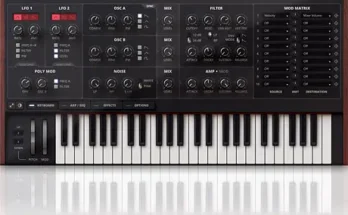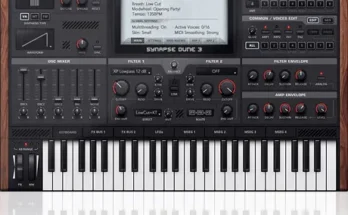MAC OSX | Team IND | 32.57 MB
Metric Halo’s ChannelStrip has been an integral part of the sound of myriad Grammy-award winning, Gold and Platinum records, hit TV shows and blockbuster movies. The first plug-in to bring classic large format console-style ChannelStrip processing to Pro Tools TDM, ChannelStrip has been the critical tool for getting “the sound” for thousands of professional recording engineers, composers and musicians world-wide.
ChannelStrip includes over 100 professionally constructed presets that are automatically installed with the plug-in that provide a wide variety of fix-its and starting points for optimizing the sound of your individual channels and mixes.
OK. So now you know that ChannelStrip is the key to the “sound” of thousands of professional productions. You can check out the quotes and user stories on this page to see just some of the folks who won’t work without it. But what is it? What will it really do for you?
It’s all about the sound!
The consistent feedback we get from ChannelStrip users is that it just makes everything that they run through it sound better. Equally at home on individual instruments and on the master bus, ChannelStrip will warm up your sound, clarify the details and make your production sound pro.
How does ChannelStrip do this?
It’s all about attention to detail. High-precision algorithms, careful attention to rounding and dither, and deep integration between all the critical processes. On the one hand, its all a bunch of technical mumbo-jumbo, but on the other hand, it has the effect of breathing life into your audio… from virtual instruments to real ones, processing vocals and complete tracks.
ChannelStrip provides all the critical components of the channel strip of a large-format mixing console. The reason that large-format consoles (the classical “big iron” — SSL/Neve/Euphonix) include this kind of processing on each channel strip is that most signals benefit from the kind of interactive processing that all the elements of ChannelStrip provide together.
The Basics
ChannelStrip includes the following critical signal processors integrated together in one easy-to-use interface:
• Delay
• Expander/Gate
• Compressor
• EQ (48-bit — the first on the platform!)
The integrated delay is useful for adjusting the relative timing of tracks; this is great if you are recording sources (like a guitar amp) with multiple microphones. While this feature can be critical in a professional environment, it is a bit on the technical side, and you may find that you never need to utilize it. But it is there if you need it! Learn more on the time alignment tab.
The Expander/Gate is a form of dynamics processing that is most useful for channels with real instruments or vocals; it provides an automatic gain-riding feature that effectively mutes the input or track when the audio level is too low. This is great when you have a noisy guitar amp or are recording a pod-cast and want to automatically mute out the rustling of papers and background noises. The Expander/Gate in ChannelStrip has a bunch of nice properties that make it really useful for maximizing the good part of a performance while cleaning up the unwanted noises. Another cool application for the Expander/Gate is its ability to change the rhythmic feel of a performance. Learn more on the expansion and gating tab.
The Compressor is the primary dynamics processing element in ChannelStrip. Similar to the Expander/Gate, it provides an automatic gain-riding feature, but instead of the gain changing when the signal is low, the compressor changes the gain when the signal level is high. By lowering the gain when the signal level is high, the compressor can even out the dynamics of a performance, pull low-level detail out of the sound, and even radically change the nature of the sound passing through it. The compressor has been compared (favorably!) with the bus compressor in the SSL mega-bucks mixing console — a processor that is much coveted for its ability to “fatten up” everything that passes through it. Learn more on the compression tab.
The EQ is, of course, the multiband equalizer. The EQ allows you to adjust the tonal balance and timbre of the signal passing through it. It is like a tone control on mega-steroids. The EQ in ChannelStrip is a 6-band fully parametric, extended range, double-precision processor. Again with the mumbo-jumbo. In the end, it means that whatever sound shaping you require is possible with the ChannelStrip EQ. The parametric bands of the EQ are capable of deep notches and steep resonant peaks. This allows you to do unique things with the EQ — like re-tuning drums after they have been recorded. Whether you use this on real instruments or virtual instruments, the EQ allows you to maximize your sound. Learn more on the EQ tab.
The Not-So-Basics
ChannelStrip provides all the basic sound-shaping tools you need. But it doesn’t stop there; ChannelStrip adds some critical advanced features that you may not find elsewhere. The most important advanced feature is the integration of equalized sidechains in both dynamics processors (the Expander/Gate and the Compressor). The equalized side-chain provides a fully-parametric equalizer in the side-chain of the dynamics processors, which allows you to tailor the response in a frequency sensitive way. This makes it possible, for example to make the compressor react more to the kick drum of a mix, or make the Expander/Gate that you put on a snare drum ignore the bleed from a hi-hat. This advanced feature makes the impossible possible and the difficult easy. Learn more about sidechains on the compression and gating tabs.
Another advanced feature of ChannelStrip is the integration and routability of the processes. One thing that you quickly learn when shaping sounds for a mix, is that all the signal processing stages interact. When you change the EQ, you also need to change the Compressor. When you adjust the Gate it effects the proper settings for the Compressor too. Sometimes the sound you are looking for requires the Compressor to come before the EQ, and sometimes the sound is best served by EQ and then compression. The User Interface of ChannelStrip supports this interactive process by integrating all the controls for all the signal processors into one control surface. The routing control for the order of the signal flow through the Compressor and EQ is integrated directly into the UI, allowing you to compare the effect of switching the routing with a single mouse click.
Perhaps the most important advanced feature of the ChannelStrip UI is that it provides detailed visual feedback about the effects of the processing applied. The UI includes detailed and accurate metering, and precise graphical representations of the transfer functions applied by each of the process blocks. The transfer functions show you, in detail, what changes will be applied to the signal by the EQ and the dynamics processors. Integrated metering in the dynamics transfer functions allow you to easily see the proper thresholds and other parameters to achieve the changes that you desire.
Presets, Presets, Presets…
The ChannelStrip plug-in product ships with over 120 carefully crafted presets to get you started quick. Professionals have found them to be great quick fixes and excellent starting points to craft their Grammy and Academy Award-winning sounds. Think of what they can do for your mixes. See them on the presets tab.
The Whole Package
The ChannelStrip Native package includes AU, VST, MAS and RTAS versions for real-time processing in every DAW, and an AudioSuite version for offline processing in Pro Tools. It also includes more than 120 general purpose ChannelStrip presets — presets to optimize your individual channels and your entire mix.
Whether you are a Mix Engineer, a Producer, a Composer, or a Musician, work in a Commercial production studio or a Home studio or are a “Hired Gun” you can use ChannelStrip to add the professional sheen to your mixes, demos, and compositions.
READ Info text well before installing!
[toggle title=”Home page”]https://tinyurl.com/rjgyqxt[/toggle]

http://alfalink.to/094286d28a53df91b802
Please REPORT in Comment Broken Links




